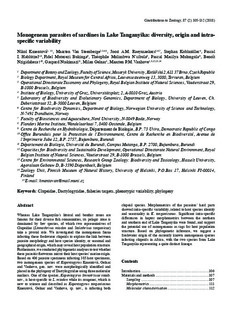| dc.contributor.author | Kmentová, Nikol | |
| dc.contributor.author | Van Steenberge, Maarten | |
| dc.contributor.author | Raeymaekers, Joost A. M. | |
| dc.contributor.author | Koblmüller, Stephan | |
| dc.contributor.author | Hablützel, Pascal I. | |
| dc.contributor.author | Muterezi Bukinga, Fidel | |
| dc.contributor.author | N'sibula, Theophile Mulimbwa | |
| dc.contributor.author | Masilya Mulungula, Pascal | |
| dc.contributor.author | Nzigidahera, Benoît | |
| dc.contributor.author | Ntakimazi, Gaspard | |
| dc.contributor.author | Gelnar, Milan | |
| dc.contributor.author | Vanhove, Maarten P. M. | |
| dc.date.accessioned | 2019-03-22T09:13:27Z | |
| dc.date.available | 2019-03-22T09:13:27Z | |
| dc.date.created | 2018-10-10T16:13:14Z | |
| dc.date.issued | 2018 | |
| dc.identifier.citation | Contributions to zoology. 2018, 87 (2), 105-132. | nb_NO |
| dc.identifier.issn | 1383-4517 | |
| dc.identifier.uri | http://hdl.handle.net/11250/2591238 | |
| dc.description.abstract | Whereas Lake Tanganyika’s littoral and benthic zones are famous for their diverse fish communities, its pelagic zone is dominated by few species, of which two representatives of Clupeidae (Limnothrissa miodon and Stolothrissa tanganicae) take a pivotal role. We investigated the monogenean fauna infecting these freshwater clupeids to explore the link between parasite morphology and host species identity, or seasonal and geographical origin, which may reveal host population structure. Furthermore, we conducted phylogenetic analyses to test whether these parasitic flatworms mirror their host species’ marine origin.
Based on 406 parasite specimens infecting 385 host specimens, two monogenean species of Kapentagyrus Kmentová, Gelnar and Vanhove, gen. nov. were morphologically identified and placed in the phylogeny of Dactylogyridae using three molecular markers. One of the species, Kapentagyrus limnotrissae comb. nov., is host-specific to L. miodon while its congener, which is new to science and described as Kapentagyrus tanganicanus Kmentová, Gelnar and Vanhove, sp. nov., is infecting both clupeid species. Morphometrics of the parasites’ hard parts showed intra-specific variability, related to host species identity and seasonality in K. tanganicanus. Significant intra-specific differences in haptor morphometrics between the northern and southern end of Lake Tanganyika were found, and support the potential use of monogeneans as tags for host population structure. Based on phylogenetic inference, we suggest a freshwater origin of the currently known monogenean species infecting clupeids in Africa, with the two species from Lake Tanganyika representing a quite distinct lineage. | nb_NO |
| dc.language.iso | eng | nb_NO |
| dc.publisher | Naturalis Biodiversity Center | nb_NO |
| dc.relation.uri | http://www.ctoz.nl/cgi/t/text/text-idx?c=ctz;sid=5889e057cef150d7c19ec3fe72132eb7;rgn=main;idno=m8702a04;view=text | |
| dc.title | Monogenean parasites of sardines in Lake Tanganyika: diversity, origin and intraspecific variability | nb_NO |
| dc.type | Journal article | nb_NO |
| dc.type | Peer reviewed | nb_NO |
| dc.description.version | publishedVersion | nb_NO |
| dc.source.pagenumber | 105-132 | nb_NO |
| dc.source.volume | 87 | nb_NO |
| dc.source.journal | Contributions to zoology | nb_NO |
| dc.source.issue | 2 | nb_NO |
| dc.identifier.cristin | 1619436 | |
| dc.description.localcode | Published by Naturalis Biodiversity Center. | nb_NO |
| cristin.unitcode | 194,66,10,0 | |
| cristin.unitname | Institutt for biologi | |
| cristin.ispublished | true | |
| cristin.fulltext | original | |
| cristin.qualitycode | 1 | |
